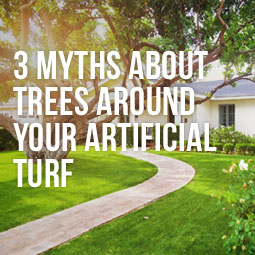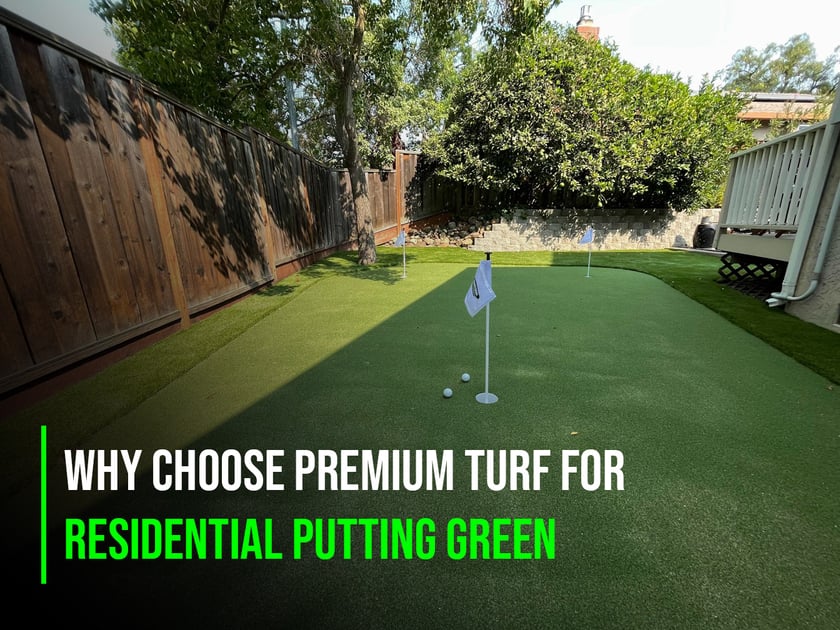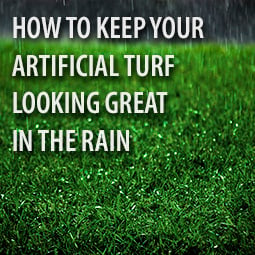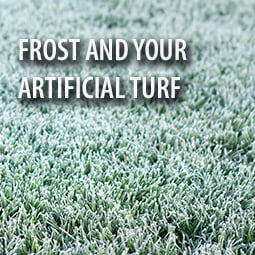
Who doesn’t love trees? They add color and texture to your yard. They frame your property and give it a “horizon.” They provide a natural jungle gym for your kids and blessed shade for the entire family when it’s hot outside. Of course you want trees! But what if you want artificial turf, too? Maybe you’ve heard that trees and synthetic grass don’t mix. That’s a myth. You can have your trees and fake grass, too.
Myth #1: Bulging tree roots will wreck your artificial turf
Roots grow downward, in search of moisture. But they also spread out, to provide stability as well as wick up nutrients and water. So some types of trees do have very shallow roots that tend to push up the soil surface over time. Conifers are notorious for this, but they’re not alone. It’s best to avoid these varieties in your yard where they will be next to or surrounded by lawn. You don’t want to plant them along your driveway or sidewalk or patio, either, because the roots can also push up concrete and pavers.
For planting new trees, you can find hundreds of gorgeous, ideal options no matter the size of your space or your personal preferences. And if you have an existing tree with bulging roots, don’t despair. Read on.
Myth #2: Artificial turf will choke out your trees
Artificial grass is not a plastic barrier. It may not be living, but it does breathe. There are dozens of synthetic grass products specifically engineered to ensure superior drainage. The barrier mesh keeps weeds from growing, but it doesn’t keep moisture from being absorbed by the soil where it can reach your trees.
Technically, you do need to install a tree ring around the trunk at a minimum of 3 feet to the edging and, in some cases, even install a drip line to help keep the tree watered. Depending on the Tree species, we recommend consulting your local arborist. Once you have this part of your project better understood your trees will be happier and healthier. For one thing, trunks expand as trees grow, and you don’t want to have to adjust your artificial grass later on to accommodate that.
This is also a great way to accommodate your existing, beloved tree that is prone to surface-breaking roots. Create an “island garden” effect that extends to include all visible roots. With ground cover or a natural mulch such as shredded bark, the roots won’t even be noticeable, let alone cause a problem. No artificial grass upheaval, no tripping hazards.
On hot, sunny days, fake grass can become warmer than natural grass. If you’re concerned about this over-warming the soil underneath, that’s not likely but you can easily cool things off by rinsing the grass with a hose. (Your bare toes will love that cool, grassy feeling, too.)
Myth #3: You can’t rake artificial turf
In other words, you supposedly won’t be able to get rid of all the leaves your trees drop. This is ridiculous. You can use an air blower on fake grass, any number of rake types, or even a power broom. Leaves and debris no more!
Not a myth: Artificial grass is actually better with trees
Trees can create deep shade, acidic soil, etc. that make it impossible to grow natural grass. But you can plant artificial turf anywhere, regardless of soil or atmospheric conditions. That means you can have the yard you want instead of the yard you’re stuck with.
The bottom line? Both real trees and fake grass increase your home’s value. Of course you want both!












